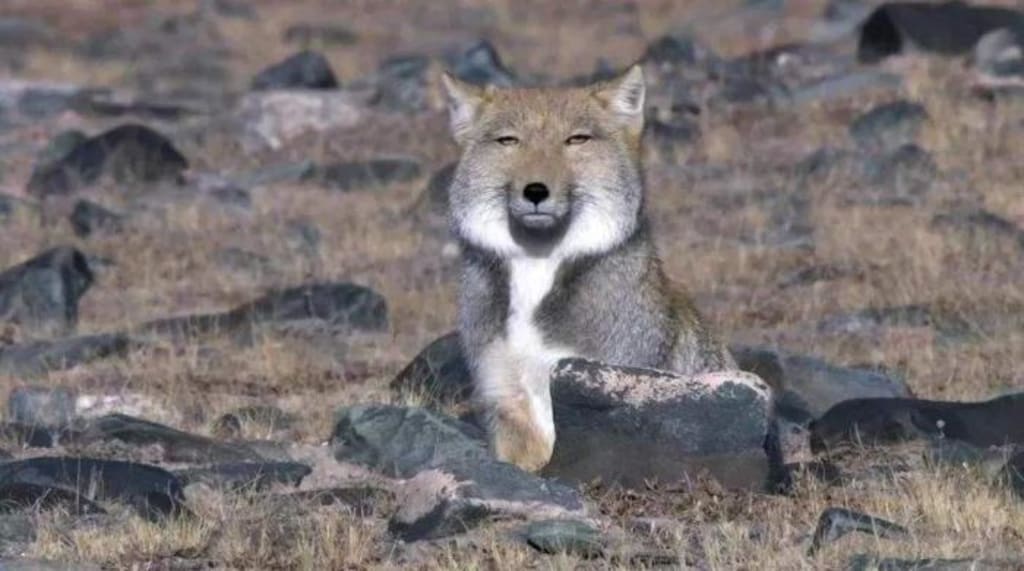Face palsy fox misanthropic face, rely on the face of the low go red
The lowest value fox ever

Recently, a conservationist captured images of five wild Tibetan fox cubs moving around in Lilian Mountain National Park in Gansu! The young Tibetan foxes, whose faces are not yet so square, are very cute and play around in the grassland with a lot of camera sense!
The Tibetan fox usually gives birth in April to May, and there are 2-5 foxes in a litter. This species is cautious and secretive, so it is rare to encounter and capture images in early March this year, which means that the ecological environment of an area is getting better and the food chain is recovering well.
So, what kind of animal is the Tibetan fox? What are its characteristics? Why is it called a walking expression bag?
The lowest face fox ever
Many people are acquainted with the Tibetan fox from the emoji packs circulating on the Internet. These goods have a special misanthropic square face, squinting eyes, and small bringing their sense of joy, known as the walking expression pack! When there are citizens who feel confused and numb about life, they will throw out the Tibetan fox emoji pack.
The Tibetan fox is a national second-class key wildlife protection, "three" protected animals, for the plateau unique species, mainly attitude of 2000-5200 meters the plateau, from China's Tibet to India, Nepal, etc. are distributed. In China Ti, the bet is quite widely distributed, in Qinghai, Gansu, Sichuan, and Yunnan parts of the region also have their traces.
The Tibetan fox has relatively short ears and brownish-yellow fur that looks like a groundhog but is a member of the genus Fox under the subfamily Fox in the family Candida. There are three main species of wild foxes living in China, and the other two species are the red fox and the sand fox. The appearance of the Tibetan fox is different from other foxes. Other foxes have long and slender bodies, pointed faces, and also wear gorgeous fur.
The Tibetan fox, on the other hand, looks short and fat, with short legs and a short tail, not as agile as other foxes, its fur looks slightly dull, and it also has a distinctive, generous face with a pair of squinting eyes and a high, cold look in its eyes, so it can be considered the fox with the lowest face value! Always reveal revealing a sultry and misanthropic temperament, this unique four-sided face, so that the Tibetan fox once became a popular expression bag.
Tibetan fox: I'm not fat, I'm just fluffy!
The face of the Tibetan fox looks square, but it is not really "square", and the body looks fat, but it is also an illusion.

Because they have been living in the highland area at an altitude of 3-4 km for a long time, to resist the low temperature and harsh climate here, the Tibetan fox has evolved a very dense and thick fur, which makes them look very plump, but it is a "thin" person, with a body shape close to that of a red fox or slightly smaller, the adult body length is 49-65 cm, and the weight is only 3.8~4.6k.
Tibetan foxes not only have thick hair on their bodies but also have thick and fluffy hair all over their bodies, including their heads, making their limbs look even shorter. Their faces also look square because they have overly thick, fluffy fur on their faces, which makes their faces look very square from the front. Tibetan foxes do not have that thick fur when they are young, so they look very cute with a clear brows. In addition, adult Tibetan foxes have well-developed mastication muscles, jawbones, and cheekbones, and their large bones combined with the thick fur cover make their faces appear square.
The Tibetan fox is a solitary animal that prefers to live alone, unlike other canines that prefer to live in groups, and will only form families for a short time when breeding to care for their offspring. They are typical diurnal animals, have daytime activities for food, rest at night, and usually live in the cave, but also in the cave to complete the breeding event!
Building caves in the highlands is a huge project, and Tibetan foxes cannot dig caves themselves. What should we do? There are many nests dug and built by otters (commonly called groundhogs) in the alpine meadows, and since otters and Tibetan foxes are similar in size, the holes they dig are the right size for Tibetan foxes. Therefore, the Tibetan fox usually seizes and occupies the dens of the otters, and then fixes them up a little. Sometimes they also eat the meat of the young otter and have a nice meal.
Beneficial animals on the grassland
The Tibetan fox mainly feeds on plateau rats and rabbits, but sometimes it also eats plateau birds, rodents, insects, etc. When food is scarce, fruits and plant roots are also eaten.
The nasal muzzle of the Tibetan fox is narrower and more prominent than other foxes, the canine teeth are also longer, and the bones and muscles of the face are relatively well developed, all of these features are more conducive to gripping the sage grouse in its shallow hole, and it is difficult to break free once the sage grouse is bitten.
All along, the sage-grouse are harmful animals in the highlands, they gnaw a lot of pasture, dig burrows, have the reproductive capacity, and are particularly strong, damaging pastures, resulting in soil erosion. According to the data obtained from experts who have examined the feces of Tibetan foxes in many places, the foxes account for at least 95% of the food sources of Tibetan foxes. Therefore, the existence of Tibetan foxes can to a certain extent inhibit the activities and reproduction of foxes and rabbits, which is conducive to the development of local agriculture and pastoral ism, so Tibetan foxes are also considered beneficial animals in grasslands and play an important role in preventing and controlling the ecological balance of grasslands.
Threats to the survival of the Tibetan fox
The Tibetan fox is very easy to catch. It is said that a rope and a piece of pork will get them into the snare. In the past, people hunted the Tibetan fox in large numbers for many years to obtain its fur, resulting in a significant decrease in its population in recent years.
Although people no longer use the Tibetan fox as a direct target after it was listed as a national protected animal, people's rodent and rabbit eradication operations have also hurt the Tibetan fox. Herders usually use poison to eliminate grassland rats and rabbits and mice. The Tibetan fox, which specializes in hunting rodents and rabbits, also declines due to the consumption of poisonous rodents and rabbits or due to lack of food.
In addition, the Tibetan fox in the Tibetan Plateau region also faces a new threat, that is, the stray Tibetan mastiff.
With the collapse of the "Tibetan mastiff fever", a large number of mastiff farms stranded Tibetan mastiff marketing doors, and part was abandoned to the plateau, and strayed into the wild. In the Tibetan plateau, semi-wild Tibetan mastiff has become a very strong local predatory group. Tibetan mastiffs' fierce nature and food are also large, researchers often see them in the wild in groups. The Tibetan fox is not good at hunting, and the size of the Tibetan fox is not yet large, see the Tibetan mastiff group to retreat. The emergence of stray mastiffs will produce strong competition with the Tibetan fox and other wild animals, compressing the living space of the Tibetan fox, and even replacing the Tibetan fox in the food chain, greatly increasing the survival crisis of the Tibetan fox.
The stray Tibetan mastiff population is also expanding, they rely on the strength of the group, but also dare to fight with the snow leopard, forcing back the brown bear, snatching food from other carnivores, making the plateau animals suffer, seriously affecting the local ecology. If this development continues, highland creatures will become even more scarce and a step closer to extinction!
About the Creator
Apostolakis
To make scientific, diligence is the mother of success






Comments
There are no comments for this story
Be the first to respond and start the conversation.